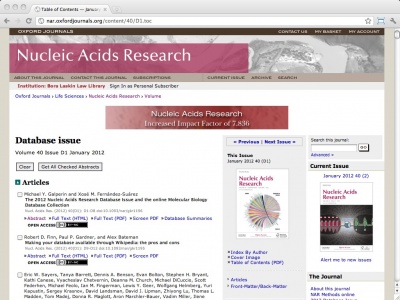Difference between revisions of "WWW NAR database"
Jump to navigation
Jump to search
m |
m |
||
| (5 intermediate revisions by the same user not shown) | |||
| Line 1: | Line 1: | ||
<div style="display: none"> | <div style="display: none"> | ||
| − | <section begin=title /> | + | <section begin=title />NAR database issue<section end=title /> |
| − | NAR database issue | ||
| − | <section end=title /> | ||
| − | <section begin=file /> | + | <section begin=file />Nar.database.jpg<section end=file /> |
| − | Nar.database.jpg | ||
| − | <section end=file /> | ||
| − | <section begin=url /> | + | <section begin=url />http://nar.oxfordjournals.org/content/42/D1.toc<section end=url /> |
| − | http://nar.oxfordjournals.org/content/ | ||
| − | <section end=url /> | ||
| − | <section begin=abstract /> | + | <section begin=abstract />Every year the journal ''Nucleic Acids Research'' (NAR) compiles a special issue on important databases in molecular biology (in January), and on important [[WWW_NAR_webserver| webservers and other resources]] (in July). The articles are peer-reviewed, and inclusion into the issue is considered a quality endorsement. Both volumes reflect the best practices in the field, as well as its rapidly changing nature. Links to databases and resources are searchable by keyword and topic in the [[WWW_Bioinformatics.ca_links|bioinformatics.ca links directory]]. <section end=abstract /> |
| − | Every year the journal ''Nucleic Acids Research'' (NAR) compiles a special issue on important databases in molecular biology (in January), and on important [[WWW_NAR_webserver| webservers and other resources]] (in July). The articles are peer-reviewed, and inclusion into the issue is considered a quality endorsement. Both volumes reflect the best practices in the field, as well as its rapidly changing nature. Links to databases and resources are searchable by keyword and topic in the [[WWW_Bioinformatics.ca_links|bioinformatics.ca links directory]]. | ||
| − | <section end=abstract /> | ||
| − | <section begin=reference /> | + | <section begin=reference />{{WWW_resource_reference_section| 24316579}}<section end=reference /> |
| − | {{WWW_resource_reference_section| | ||
| − | <section end=reference /> | ||
<!-- DONT EDIT BELOW --> | <!-- DONT EDIT BELOW --> | ||
Latest revision as of 01:08, 9 January 2015
NAR database issue |
URL
http://nar.oxfordjournals.org/content/42/D1.toc
Abstract
Every year the journal Nucleic Acids Research (NAR) compiles a special issue on important databases in molecular biology (in January), and on important webservers and other resources (in July). The articles are peer-reviewed, and inclusion into the issue is considered a quality endorsement. Both volumes reflect the best practices in the field, as well as its rapidly changing nature. Links to databases and resources are searchable by keyword and topic in the bioinformatics.ca links directory.
Reference
| Fernández-Suárez et al. (2014) The 2014 Nucleic Acids Research Database Issue and an updated NAR online Molecular Biology Database Collection. Nucleic Acids Res 42:D1-6. (pmid: 24316579) |
